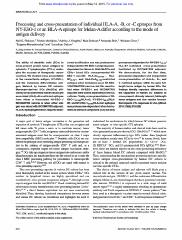Please use this identifier to cite or link to this item:
https://ahro.austin.org.au/austinjspui/handle/1/11027| Title: | Processing and cross-presentation of individual HLA-A, -B, or -C epitopes from NY-ESO-1 or an HLA-A epitope for Melan-A differ according to the mode of antigen delivery. | Austin Authors: | Robson, Neil C;McAlpine, Tristan;Knights, Ashley J;Schnurr, Max;Shin, Amanda;Chen, Weisan;Maraskovsky, Eugene;Cebon, Jonathan S | Affiliation: | neil.robson@ed.ac.uk Ludwig Institute for Cancer Research, Centre for Clinical Sciences, Austin Health, Heidelberg, Victoria, Australia 3084, Australia |
Issue Date: | 29-Apr-2010 | Publication information: | Blood 2010; 116(2): 218-25 | Abstract: | The ability of dendritic cells (DCs) to cross-present protein tumor antigens to cytotoxic T lymphocytes (CTLs) underpins the success of therapeutic cancer vaccines. We studied cross-presentation of the cancer/testis antigen, NY-ESO-1, and the melanoma differentiation antigen, Melan-A by human DC subsets. Monocyte-derived DCs (MoDCs) efficiently cross-presented human leukocyte associated (HLA)-A2-restricted epitopes from either a formulated NY-ESO-1/ISCOMATRIX vaccine or when either antigen was mixed with ISCOMATRIX adjuvant. HLA-A2 epitope generation required endosomal acidification and was proteasome-independent for NY-ESO-1 and proteasome-dependent for Melan-A. Both MoDCs and CD1c(+) blood DCs cross-presented NY-ESO-1-specific HLA-A2(157-165)-, HLA-B7(60-72)-, and HLA-Cw3(92-100)-restricted epitopes when formulated as an NY-ESO-1/ISCOMATRIX vaccine, but this was limited when NY-ESO-1 and ISCOMATRIX adjuvant were added separately to the DC cultures. Finally, cross-presentation of NY-ESO-1(157-165)/HLA-A2, NY-ESO-1(60-72)/HLA-B7, and NY-ESO-1(92-100)/HLA-Cw3 epitopes was proteasome-dependent when formulated as immune complexes (ICs) but only proteasome-dependent for NY-ESO-1(60-72)/HLA-B7-restricted cross-presentation facilitated by ISCOMATRIX adjuvant. We demonstrate, for the first time, proteasome-dependent and independent cross-presentation of HLA-A-, B-, and C-restricted epitopes within the same full-length tumor antigen by human DCs. Our findings identify important differences in the capacities of human DC subsets to cross-present clinically relevant, full-length tumor antigens and how vaccine formulation impacts CTL responses in vivo. | Gov't Doc #: | 20430956 | URI: | https://ahro.austin.org.au/austinjspui/handle/1/11027 | DOI: | 10.1182/blood-2009-10-249458 | Journal: | Blood | URL: | https://pubmed.ncbi.nlm.nih.gov/20430956 | Type: | Journal Article | Subjects: | Antigen Presentation.immunology Antigens, Neoplasm.immunology Cancer Vaccines.immunology Cholesterol.immunology Cross-Priming.immunology Dendritic Cells.immunology Drug Combinations Epitopes, T-Lymphocyte.immunology HLA-A Antigens.immunology HLA-B Antigens.immunology HLA-C Antigens.immunology Histocompatibility Antigens Class I.immunology Humans Lymphocyte Activation.immunology MART-1 Antigen Neoplasm Proteins.immunology Peptide Fragments.immunology Phospholipids.immunology Proteasome Endopeptidase Complex.immunology Saponins.immunology |
| Appears in Collections: | Journal articles |
Files in This Item:
| File | Description | Size | Format | |
|---|---|---|---|---|
| 20430956.pdf | 266.71 kB | Adobe PDF |  View/Open |
Page view(s)
66
checked on Feb 20, 2025
Download(s)
108
checked on Feb 20, 2025
Google ScholarTM
Check
Items in AHRO are protected by copyright, with all rights reserved, unless otherwise indicated.
